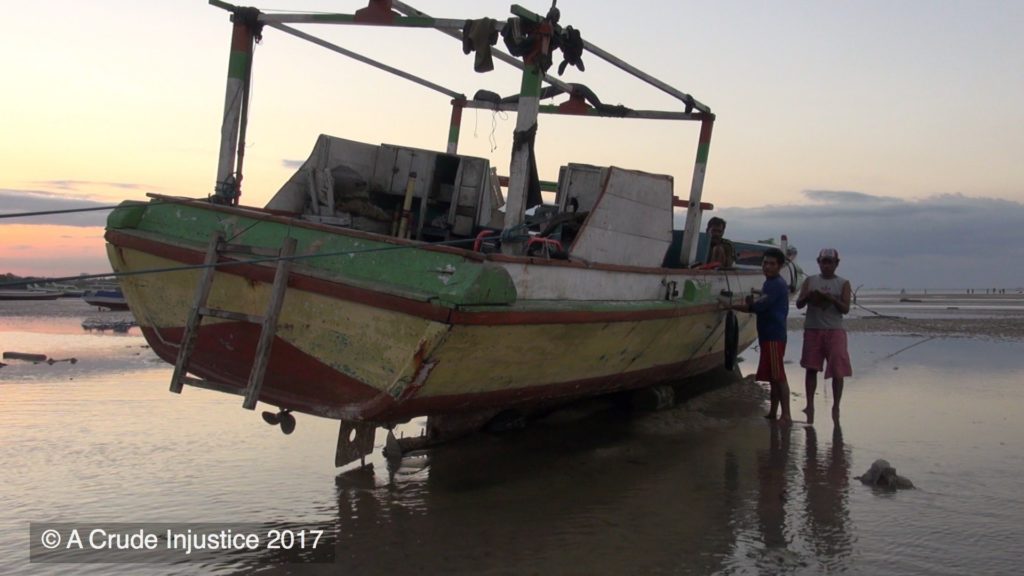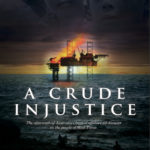A Crude Injustice


Aside from being a woman reporting facts for news reviewers, Jane Hammond’s persistence clearly resonates in her quest to reveal one of the oldest crimes of men, murder. Not the type of murder where one stalks a person and suddenly a gleam of light reflecting from a blade before plunging it into the jugular can be seen. No, that would nearly be merciful. These greedy perpetrators are slowly tightening their hands with grins stretched across their faces, one hand clutching the throat of Timor residents and the other around a fistful of cold hard cash all in the name of oil.
Despite the tragedy occurring over seven years ago, the Timor residents carry on in an effort to raise their families on the unforgiving coastline refusing to yield the seaweed that once provided a prosperous life. While showing the calm and serene waters beneath a clear blue sky, Jane Hammond reveals to us that appearances can be deceiving with the aid of hope and desperation. The livelihood of creating a legacy for their offspring by affording college degrees is washed away with the fish.
The score for the film precisely describes the events taking place without the use of the narrator. However, the urgency in his voice emphasizes the peril even more. Through the viewpoint of the fishers, farmers, legal representation, and even your own eyes, you’ll see the mystery unfold pointing its finger, through the eerie music, into the faces of the culprits. There is one dividing factor between those struggling with their very lives to survive and those relishing the effects—crude oil.
On August 21, 2009, photographs were taken of PTTEP’s Montara Platform in the waters off the coast of Timor with smoke billowing toward the sky in plumes with the gray sky behind it. Millions of liters of the oil can clearly be detected in the water spreading out over an area of more than 90,000 kilometers, the narrator describes. The 69 crewmembers, rightly fearing for their lives, abandoned Montara Platform and allowed the oil to flow freely on its own, contaminating the waters and everyone surrounding the devastating leakage.
Environment Campaigner Martin Pritchard conveys from a black background of solidarity that the lone and abandoned rig continuously spewed oil, and there was nothing they could do but watch Timor’s income and health wash away in the still waters. An accurately established map shows where the oil originated, and how the current carried the pollutant from Montara Platform toward the shores of Timor.
In this film, not only do we hear the facts of the event, we see the struggling people and their hungry dogs waiting for any small scrap tossed their way. Just as the ravenous animals anxiously await food, we also see the people wading in from the waters with baskets braced on their shoulders carrying infected seaweed in hopes of scavenging enough to make their trip worthwhile. Unoccupied boats float drifting against the backdrop of the darkening sky.
PTTEP sprayed a chemical on the infected area causing the oil to “vanish” and followed up with a visual written report stating there’s little proof of the occurrence. Although unseen on the surface, Science tells us nothing ever disappears; rather it takes on a new form as the oil did in a waxy sinking mass, as shown by Tropical Ecologist Gilly Llewellyn, to sink below the surface, undetected. We see the oil’s journey on satellite imagery.
After careful studies of the situation, a document was drawn up and given to the government displaying 92 citing 105 recommendations after the leak was plugged in late 2009. The regulators also discovered that none of the five Montara wells fully complies with legal requirements.
Today, PTTEP continue its use of at least 10 platforms, taking what they’ve deemed so important the sea life, animals, and humanity remain in the dust of what was. Those who continue their contact with the waters will pay dearly with brutal lumps, bumps, pits, open wounds, and scars to remind them that what was once theirs is taken without recourse. The film wraps up with startling statistics of PTTEP’s refusal to comment other than stating the evidence considered is “highly improbable.”
Although some of the camera work and sound could stand better regulation, the story didn’t lose any punch.





